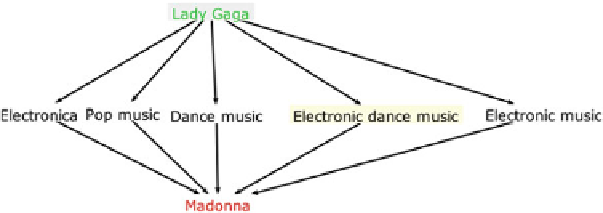Information Technology Reference
In-Depth Information
w
0
w
1
n
w
=
∑
(a)
w
i
i=0
w
n
w
0
w
1
w
n
...
n
w
=
ʳ
ʠ
n
w
(b)
i
i=0
Fig. 7.10
The figure shows the formulas for calculating the path weights for
a
parallel edges and
b
for a sequence of edges. The discount factor
γ
ensures that short paths get higher weighting than
long paths
paths from the user profile exist and the shorter (based on the number of edges) the
paths are. Also, the type of edge is taken into account. We evaluate for different path
lengths how the profile enhancement influences the CF performance.
To give an impression of how the system computes related entities, Figs.
7.11
and
7.12
show example computations using only artist and genre nodes and edges
connecting the nodes. Figure
7.11
shows a possible enrichment based on a user profile
containing “Lady Gaga” as an interest. The path length is set to two; this means that
only entities that are not more than two steps away are taken into account. In this
example, “Madonna” would be used to enrich the user profile. Figure
7.12
shows the
enrichment going to a depth of four. This means that entities that are not more than
four steps away are taken into account. Input is the same user profile, with “Lady
Gaga” as an interest.
7.4.1.2 Memory-Based Link Prediction
We apply a path-based approach for computing predictions. Starting from several
input entities (e.g., the entities in the user profile), we traverse the semantic network.
The entities reachable from the input entities are ordered according to a semantic
similarity rating. This rating is calculated based on the edge weights of the respective
Fig. 7.11
Path Length 2: Explanation of path-based enrichments over the Artist-Genre edge set.
The user can see the different nodes that were used for enrichment with Madonna














Search WWH ::

Custom Search